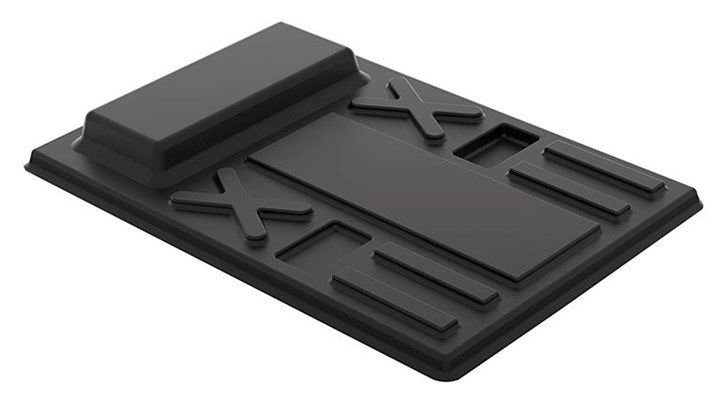SABIC launches fiber-reinforced, intumescent, fire-retardant resins
SABIC PP compound H1090 and Stamax 30YH611 resins are well suited for extruding and thermoforming large, complex EV battery pack components for automotive.

Photo Credit: SABIC
SABIC (Riyadh, Saudi Arabia, and Houston, Texas, U.S.) is introducing SABIC PP compound H1090 and Stamax 30YH611 resins, two materials well suited for sheet extrusion and thermoforming. They offer an alternative to traditional sheet metal forming, and compression and injection molding, the company says, enabling customers to form large, complex structural parts.
The 30% glass fiber-reinforced polypropylene resins, which are intumescent and flame-retardant (FR), can be used for electric vehicle (EV) battery pack components such as top covers, enclosures and module separators. Both grades offer optimized thermal barrier properties to help delay or contain thermal runaway propagation. Furthermore, extruding or thermoforming these materials are reported to offer design, system cost, inherent thermal and electrical insulation and weight advantages versus stamped sheet metal. Moreover, compared to injection molding thermoplastics and compression molding thermosets — which requires expensive tooling and equipment — SABIC points out that extrusion and thermoforming can be more cost-effective and efficient for several cases.
Thanks to Bluehero, an initiative that supports the automotive industry’s mission to create reliable, safe and efficient EVs, SABIC has validated the mechanical and fire safety performance and the manufacturability of SABIC PP compound H1090 resin and Stamax 30YH611 resin in EV battery applications with complex geometries, both in its labs and with customers.
Both short glass fiber-reinforced SABIC PP compound H1090 resin and long glass fiber-reinforced STAMAX 30YH611 resin feature a distinct combination of intumescence for fire safety and balanced stiffness and ductility. Exposing these materials to vertical and horizontal flames at 1,200°C for 10 minutes demonstrates optimal flame-retardant behavior. Efficient charring and intumescence keep the temperature of the reverse side of parts lower than 210°C and help prevent burn-through. Intumescence is enhanced by non-brominated/non-chlorinated FR that meets the UL94 V0 standard at 1.5 mm. The video below demonstrates a thermal runaway test performed with one of SABIC’s Stamax resins.
In addition to high stiffness, strength and impact resistance over a wide temperature range, key properties of SABIC PP compound H1090 resin and Stamax 30YH611 resin include dimensional stability, low coefficient of thermal expansion and good creep resistance. As the polymer matrix for both products, polypropylene offers good electrical insulating properties, low density, global availability and good processability.
In addition to these products, SABIC offers injection and compression moldable FR long- and short-glass polypropylene materials— also well suited for several internal components and complete enclosures of EV battery packs.
Related Content
-
Manufacturing the MFFD thermoplastic composite fuselage
Demonstrator’s upper, lower shells and assembly prove materials and new processes for lighter, cheaper and more sustainable high-rate future aircraft.
-
Infinite Composites: Type V tanks for space, hydrogen, automotive and more
After a decade of proving its linerless, weight-saving composite tanks with NASA and more than 30 aerospace companies, this CryoSphere pioneer is scaling for growth in commercial space and sustainable transportation on Earth.
-
Plant tour: Albany Engineered Composites, Rochester, N.H., U.S.
Efficient, high-quality, well-controlled composites manufacturing at volume is the mantra for this 3D weaving specialist.
















